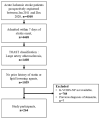High ApoB/ApoA-I Ratio Predicts Post-Stroke Cognitive Impairment in Acute Ischemic Stroke Patients with Large Artery Atherosclerosis
- PMID: 37960323
- PMCID: PMC10648714
- DOI: 10.3390/nu15214670
High ApoB/ApoA-I Ratio Predicts Post-Stroke Cognitive Impairment in Acute Ischemic Stroke Patients with Large Artery Atherosclerosis
Abstract
Background: We aimed to investigate the association between the ApoB/ApoA-I ratio and post-stroke cognitive impairment (PSCI) in patients with acute stroke of large artery atherosclerosis etiology.
Methods: Prospective stroke registry data were used to consecutively enroll patients with acute ischemic stroke due to large artery atherosclerosis. Cognitive function assessments were conducted 3 to 6 months after stroke. PSCI was defined as a z-score of less than -2 standard deviations from age, sex, and education-adjusted means in at least one cognitive domain. The ApoB/ApoA-I ratio was calculated, and patients were categorized into five groups according to quintiles of the ratio. Logistic regression analyses were performed to assess the association between quintiles of the ApoB/ApoA-I ratio and PSCI.
Results: A total of 263 patients were included, with a mean age of 65.9 ± 11.6 years. The median NIHSS score and ApoB/ApoA-I ratio upon admission were 2 (IQR, 1-5) and 0.81 (IQR, 0.76-0.88), respectively. PSCI was observed in 91 (34.6%) patients. The highest quintile (Q5) of the ApoB/ApoA-I ratio was a significant predictor of PSCI compared to the lowest quintile (Q1) (adjusted OR, 3.16; 95% CI, 1.19-8.41; p-value = 0.021) after adjusting for relevant confounders. Patients in the Q5 group exhibited significantly worse performance in the frontal domain.
Conclusions: The ApoB/ApoA-I ratio in the acute stage of stroke independently predicted the development of PSCI at 3-6 months after stroke due to large artery atherosclerosis. Further, a high ApoB/ApoA-I ratio was specifically associated with frontal domain dysfunction.
Keywords: apolipoprotein; atherosclerosis; dementia; stroke.
Conflict of interest statement
The authors declare no conflict of interest.
References
-
- Gorelick P.B., Scuteri A., Black S.E., Decarli C., Greenberg S.M., Iadecola C., Launer L.J., Laurent S., Lopez O.L., Nyenhuis D., et al. Vascular contributions to cognitive impairment and dementia: A statement for healthcare professionals from the american heart association/american stroke association. Stroke. 2011;42:2672–2713. doi: 10.1161/STR.0b013e3182299496. - DOI - PMC - PubMed
MeSH terms
Substances
Grants and funding
LinkOut - more resources
Full Text Sources
Medical
Miscellaneous


